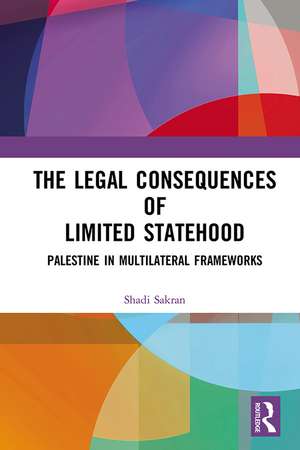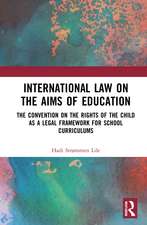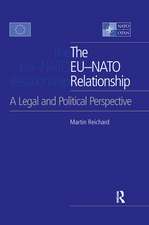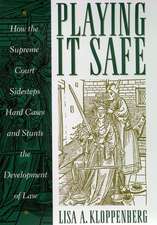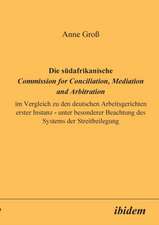The Legal Consequences of Limited Statehood: Palestine in Multilateral Frameworks
Autor Shadi Sakranen Limba Engleză Hardback – 2 dec 2019
Using Palestine as a case study, this book argues that participation in a State-reserved regime is not determined by the traditional requisites of statehood. UNESCO membership unveils the acceptance of Palestine as a State for the limited purpose of the organization, without any immediate or implicit implications for the statehood of Palestine. Palestine’s accessions to various multilateral treaties demonstrate this argument as do its instruments of accession being accepted by the depositaries of both the United Nations Secretary-General and national Governments without requiring any clarification of the statehood question. This book also provides the first in-depth study of the legal relationship of the rights and duties of Palestine with different groups of State Parties; the recent dispute settlement brought by Palestine against the United States and Israel; and theoretical and practical challenges for Palestine in its acceptance as a State in multilateral frameworks.
The book will be of interest to scholars and students of international law, legal theory, state law, and Middle East studies.
| Toate formatele și edițiile | Preț | Express |
|---|---|---|
| Paperback (1) | 384.86 lei 6-8 săpt. | |
| Taylor & Francis – 13 dec 2021 | 384.86 lei 6-8 săpt. | |
| Hardback (1) | 764.20 lei 6-8 săpt. | |
| Taylor & Francis – 2 dec 2019 | 764.20 lei 6-8 săpt. |
Preț: 764.20 lei
Preț vechi: 1027.40 lei
-26% Nou
Puncte Express: 1146
Preț estimativ în valută:
146.24€ • 151.82$ • 121.95£
146.24€ • 151.82$ • 121.95£
Carte tipărită la comandă
Livrare economică 22 martie-05 aprilie
Preluare comenzi: 021 569.72.76
Specificații
ISBN-13: 9780367410278
ISBN-10: 0367410273
Pagini: 230
Ilustrații: 2
Dimensiuni: 156 x 234 mm
Greutate: 0.45 kg
Ediția:1
Editura: Taylor & Francis
Colecția Routledge
Locul publicării:Oxford, United Kingdom
ISBN-10: 0367410273
Pagini: 230
Ilustrații: 2
Dimensiuni: 156 x 234 mm
Greutate: 0.45 kg
Ediția:1
Editura: Taylor & Francis
Colecția Routledge
Locul publicării:Oxford, United Kingdom
Public țintă
PostgraduateCuprins
Table of Contents
Acknowledgments
Acronyms
Table of International Instruments
Table of International Documents
Chapter 1
Limited Statehood in Multilateral Frameworks
1. General introduction
2. Why Palestine?
3. Research questions
4. Objectives and structure of the Book
5. The statehood question of Palestine?
Bibliography
Part 1 (Chapters 2-4)Palestine in International Organizations
Chapter 2
Preliminary Examinations on Admissions to International Organizations
1. Admissions to international organizations
2. Rejection of implicit statehood
3. Rejection of collective recognition
4. Concluding observations
Bibliography
Chapter 3Palestine in the UN: The Status of the Non-Member Observer State and its Consequences
1. Introduction
2. Historical background: Palestine’s status in the UN until Resolution 67/19
3. Does UN General Assembly Resolution 67/19 create a fully-fledged State of Palestine?
3.1. First argument: the term "State" may be taken to mean a fully-fledged State
3.2. Second argument: treating Palestine as an observer State may be binding upon all UN Member States
3.3. Third argument: those who voted for Resolution 67/19 must treat Palestine as a State
4. The consequences of the non-member observer State-status of Palestine
5. Conclusion
Bibliography
Chapter 4
Palestine in One of the Specialized Agencies of the UN: Palestine’s Admission to UNESCO and its Consequences
1. Introduction
2. Three hypotheses for the UNESCO admission clause
3. State in the UNESCO admission clause
3.1. The interpretation of the term "State" in the UNESCO admission clause
3.2. The practice of UNESCO in admitting Member States within the scope of Article II(2) of UNESCO’s Constitution
4. The admission of Palestine as a Member State by UNESCO
4.1. Palestine’s commitment and ability to carry out the functions of UNESCO
4.2. Voting record on Palestine’s admission to UNESCO
4.3. Concluding observations
5. The consequences of Palestine’s admission to UNESCO
5.1. Palestine’s relationship with opposing Member States after its admission
5.2. Palestine’s accession to UNESCO Treaties and their significant consequences
5.3. The entrance ticket of Palestine to Vienna Formula treaties
5.4. Political consequences of Palestine’s admission to UNESCO
6. Conclusion
Bibliography
Part 2 (Chapters 5-6)
Palestine in Multilateral Treaties
Chapter 5
Palestine’s Accession to Multilateral Treaties: The Circumvention of the Statehood Question by the Depositary
1. Introduction
2. Depositaries’ acceptance of the Palestinian instruments of accession
3. Multilateral treaties deposited with the UN Secretary-General
3.1. The "Vienna" clause:
3.2. All/Any States clause:
3.3. Concluding observations
4. Multilateral treaties deposited with national Governments
4.1. The Geneva Conventions and their Additional Protocols
4.2. The Hague Conventions and the Permanent Court of Arbitration
4.2.1. The "subsequent agreement" for accession to the 1907 Hague Convention for the Pacific Settlement
4.2.2. The role of the depositary: absence of institutional guidelines
4.2.3. The PCA Council has no Authority to suspend Palestine’s accession
4.2.4. Concluding observations
4.3. Multiple national Governments as depositaries: The NPT and BWC
5. Conclusion
Bibliography
Chapter 6
Consequences of Palestine’s Accession to Multilateral Treaties: Legal Relationships, Dispute Settlements and Functions of a Limited State
1. Introduction
2. Consequences for different groups of State Parties
2.1. Consequences for "silent States": silence may be seen as an acquiescence
2.2. Consequences of "purported" accessions for opposing States
3. Dispute settlements: Palestine against the United States and Israel
3.1. Palestine at the gates of the ICJ: Palestine against the United States
3.2. Palestine’s inter-State complaint against the State of Israel
4. Acting like a State
4.1. Substantive functions
4.2. Procedural functions
4.2.1. Submitting national reports
4.2.2. Participating in treaties’ conferences
5. Conclusion
Bibliography
Chapter 7
The Challenges for Palestine’s Participation as a State in Multilateral Frameworks: Imbalance, Occupation, and the Perceived Threat to the Peace Process
1. Introduction
2. Imbalanced participation in multilateral frameworks
2.1. Disadvantages compared to a formal State
2.2. Advantages compared to a formal State
3. Palestine as occupied territory
3.1. The requisite of effective control
3.2. Difficulties in implementing treaties’ provisions as a result of the occupation
4. Perceived threat to the peace process in the Middle East
5. Concluding observations
Bibliography
Chapter 8
Conclusion
1. Limited Statehood
2. The limited statehood of Palestine in multilateral frameworks
3. The legal consequences of limited statehood and the circumvention of the statehood question of Palestine
3.1. Confirmation of the general findings: observer State does not imply statehood
3.2. Limited Statehood of Palestine in international organizations
3.3. Limited Statehood of Palestine in multilateral treaties
4. Legal consequences of limited statehood of Palestine in multilateral frameworks
4.1. The contrast of what Palestine could do before and after its admission or accession
4.1.1. Palestine’s international legal capacity
4.1.2. Asserting sovereign rights over the Palestinian territory
4.1.3. Settling disputes in the international arena
4.2. Palestine’s legal relationships with different groups of State Parties
5. Final remarks: abandoning the traditional requisites of statehood?
Bibliography
Annex (1): List of Tables
Table (1): Countries Who Recognized Palestine as a State
Table (2): Voting Record of UN General Assembly Resolution 67/19
Table (3): Voting Record of the Executive Board on the Request of the Admission of Palestine to UNESCO
Table (4): Voting Record of the General Conference on the Request of the Admission of Palestine to UNESCO
Table (5): Countries Who Joined UNESCO Before their UN Admission
Table (6): Multilateral Treaties Deposited with the Director-General of UNESCO that were Acceded to by Palestine
Table (7): Multilateral Treaties Deposited with the UN Secretary-General that were Acceded to by Palestine
Table (8): Multilateral Treaties Deposited with National Governments that were Acceded to by Palestine
Table (9): Instruments of Accession, Ratification and Succession Deposited with the Three Depositories of the NPT
Annex (2): Maps of Palestine
Map (1): Plan of Partition
Map (2): City of Jerusalem
Acknowledgments
Acronyms
Table of International Instruments
Table of International Documents
Chapter 1
Limited Statehood in Multilateral Frameworks
1. General introduction
2. Why Palestine?
3. Research questions
4. Objectives and structure of the Book
5. The statehood question of Palestine?
Bibliography
Part 1 (Chapters 2-4)Palestine in International Organizations
Chapter 2
Preliminary Examinations on Admissions to International Organizations
1. Admissions to international organizations
2. Rejection of implicit statehood
3. Rejection of collective recognition
4. Concluding observations
Bibliography
Chapter 3Palestine in the UN: The Status of the Non-Member Observer State and its Consequences
1. Introduction
2. Historical background: Palestine’s status in the UN until Resolution 67/19
3. Does UN General Assembly Resolution 67/19 create a fully-fledged State of Palestine?
3.1. First argument: the term "State" may be taken to mean a fully-fledged State
3.2. Second argument: treating Palestine as an observer State may be binding upon all UN Member States
3.3. Third argument: those who voted for Resolution 67/19 must treat Palestine as a State
4. The consequences of the non-member observer State-status of Palestine
5. Conclusion
Bibliography
Chapter 4
Palestine in One of the Specialized Agencies of the UN: Palestine’s Admission to UNESCO and its Consequences
1. Introduction
2. Three hypotheses for the UNESCO admission clause
3. State in the UNESCO admission clause
3.1. The interpretation of the term "State" in the UNESCO admission clause
3.2. The practice of UNESCO in admitting Member States within the scope of Article II(2) of UNESCO’s Constitution
4. The admission of Palestine as a Member State by UNESCO
4.1. Palestine’s commitment and ability to carry out the functions of UNESCO
4.2. Voting record on Palestine’s admission to UNESCO
4.3. Concluding observations
5. The consequences of Palestine’s admission to UNESCO
5.1. Palestine’s relationship with opposing Member States after its admission
5.2. Palestine’s accession to UNESCO Treaties and their significant consequences
5.3. The entrance ticket of Palestine to Vienna Formula treaties
5.4. Political consequences of Palestine’s admission to UNESCO
6. Conclusion
Bibliography
Part 2 (Chapters 5-6)
Palestine in Multilateral Treaties
Chapter 5
Palestine’s Accession to Multilateral Treaties: The Circumvention of the Statehood Question by the Depositary
1. Introduction
2. Depositaries’ acceptance of the Palestinian instruments of accession
3. Multilateral treaties deposited with the UN Secretary-General
3.1. The "Vienna" clause:
3.2. All/Any States clause:
3.3. Concluding observations
4. Multilateral treaties deposited with national Governments
4.1. The Geneva Conventions and their Additional Protocols
4.2. The Hague Conventions and the Permanent Court of Arbitration
4.2.1. The "subsequent agreement" for accession to the 1907 Hague Convention for the Pacific Settlement
4.2.2. The role of the depositary: absence of institutional guidelines
4.2.3. The PCA Council has no Authority to suspend Palestine’s accession
4.2.4. Concluding observations
4.3. Multiple national Governments as depositaries: The NPT and BWC
5. Conclusion
Bibliography
Chapter 6
Consequences of Palestine’s Accession to Multilateral Treaties: Legal Relationships, Dispute Settlements and Functions of a Limited State
1. Introduction
2. Consequences for different groups of State Parties
2.1. Consequences for "silent States": silence may be seen as an acquiescence
2.2. Consequences of "purported" accessions for opposing States
3. Dispute settlements: Palestine against the United States and Israel
3.1. Palestine at the gates of the ICJ: Palestine against the United States
3.2. Palestine’s inter-State complaint against the State of Israel
4. Acting like a State
4.1. Substantive functions
4.2. Procedural functions
4.2.1. Submitting national reports
4.2.2. Participating in treaties’ conferences
5. Conclusion
Bibliography
Chapter 7
The Challenges for Palestine’s Participation as a State in Multilateral Frameworks: Imbalance, Occupation, and the Perceived Threat to the Peace Process
1. Introduction
2. Imbalanced participation in multilateral frameworks
2.1. Disadvantages compared to a formal State
2.2. Advantages compared to a formal State
3. Palestine as occupied territory
3.1. The requisite of effective control
3.2. Difficulties in implementing treaties’ provisions as a result of the occupation
4. Perceived threat to the peace process in the Middle East
5. Concluding observations
Bibliography
Chapter 8
Conclusion
1. Limited Statehood
2. The limited statehood of Palestine in multilateral frameworks
3. The legal consequences of limited statehood and the circumvention of the statehood question of Palestine
3.1. Confirmation of the general findings: observer State does not imply statehood
3.2. Limited Statehood of Palestine in international organizations
3.3. Limited Statehood of Palestine in multilateral treaties
4. Legal consequences of limited statehood of Palestine in multilateral frameworks
4.1. The contrast of what Palestine could do before and after its admission or accession
4.1.1. Palestine’s international legal capacity
4.1.2. Asserting sovereign rights over the Palestinian territory
4.1.3. Settling disputes in the international arena
4.2. Palestine’s legal relationships with different groups of State Parties
5. Final remarks: abandoning the traditional requisites of statehood?
Bibliography
Annex (1): List of Tables
Table (1): Countries Who Recognized Palestine as a State
Table (2): Voting Record of UN General Assembly Resolution 67/19
Table (3): Voting Record of the Executive Board on the Request of the Admission of Palestine to UNESCO
Table (4): Voting Record of the General Conference on the Request of the Admission of Palestine to UNESCO
Table (5): Countries Who Joined UNESCO Before their UN Admission
Table (6): Multilateral Treaties Deposited with the Director-General of UNESCO that were Acceded to by Palestine
Table (7): Multilateral Treaties Deposited with the UN Secretary-General that were Acceded to by Palestine
Table (8): Multilateral Treaties Deposited with National Governments that were Acceded to by Palestine
Table (9): Instruments of Accession, Ratification and Succession Deposited with the Three Depositories of the NPT
Annex (2): Maps of Palestine
Map (1): Plan of Partition
Map (2): City of Jerusalem
Notă biografică
Shadi Sakran is an attorney admitted in Israel and currently a post-doctoral researcher at the Graduate School of International Cooperation Studies (GSICS), Kobe University, Japan.
Descriere
This book analyses Palestine’s acceptance as a State in multilateral frameworks and its legal consequences.
